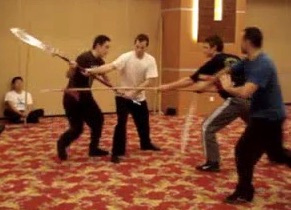CONTENT AND HIGH LEVEL SKILLS OF A SHAOLIN WAHNAM KUNGFU PRACTITIONER

The high-level skills of a Shaolin Wahnam kungfu practitioner
Question
As we know levels 10-12 require a lot of skills and good performance. What was the content, and how were the training methods to these high-end levels in
- Sitaigung Lai Chin Wah's school
- Sitaigung Chee Kim Thong's school
- Sitaigung Ho Fat Nam's school
- Sitaigung Choe Hoong Choy's school
- The Shaolin Temple?
Answer
I learned from Uncle Righteousness the concept or righteousness, and he was very particular in picture-perfect form as it gave the best advantages in any combat situation. I learned from Sifu Chee Kim Thong how to be relaxed and be focused, and he was best known for internal force. I didn't learn any internal force from his school, except on the receiving end.
My third sifu, Sifu Ho Fatt Nam, was famous for having a clear conscience. I learned internal force and combat application from him. I learned humbleness from my fourth sifu, Sifu Choe Hoong Choy. He could strike down an opponent with his economy of movement. All my sifus impressed upon me the importance of "safety first".
Shaolin Kungfu is not taught in the current Shaolin Temple. In the past it was famous for combat efficiency, internal force and spiritual cultivation.
In both our Shaolin syllabus and the Tajiquan syllabus, the following is mentioned.
Level 10: Unarmed against Armed
Form: Empty Hands Enter White Blade.
Application: Unarmed against dagger, staff and sabre.
Force: Countering feign moves.
Philosophy: The principles and practice of Apparent and Real.
Note: “Over Bridge, Flow with Water”.
Level 11: Single Unarmed against Multiple Unarmed
Form: Tiger Enters Herd of Sheep.
Application: Single unarmed against multiple unarmed.
Force: “Bamboo Man” or “Through the Woods”.
Philosophy: “Back-wall battle” and “Dodge-hit battle”.
Note: Agility, stamina and endurance.
Level 12: Single Unarmed and Armed against Multiple Armed
Form: Dodge Hit.
Application: Single unarmed and armed against multiple armed.
Force: Dodging skills and using enemy as shields.
Philosophy: “Catch the Leader First” and “Break Through the Weakest”.
Note: Importance of mind and energy control.
In Level 10, both Shaolin and Taijiquan students, being unarmed themselves, learn how to handle an armed opponent holding a dagger, a staff or a sabre. They also learn how to counter feign moves. They learn the difference between apparent and real, and understand the philosophy of “when there is a bridge, go over the bridge; if there is no bridge, flow with the water.”
In Level 11, students learn how to fight against multiple unarmed opponents. They apply the principle of “a tiger enters a herd of sheep”. They learn “Bamboo Man” or “Through the Wood”. When I was in Alor Star, I spent some time practicing with “Bamboo Man”. The students learn the philosophy of “back-wall battle” and “dodge-hit battle”, and understand how to have agility, stamina and endurance.
Our training in neigong, or internal arts, provides us with agility, stamina and endurance. An excellent example of relevant exercises is the Eighteen Lohan Art. Participants in our Intensive Shaolin Kungfu Course and Intensive Taijiquan Course, which are of a lower level than the Becoming a Shaolin Wahnam Kungfu Practitioner Course, can spar for a few hours without being tired or being panting for breath. This shows stamina and endurance.
In Level 12, which is the highest level of both the Shaolin and the Taijiquan syllabus, students being unarmed learned to fight against multiple armed opponents holding various weapons. They understand the philosophy of “dodge-hit battle”, capture an opponent’s weapon, and use opponents as shields. They learn the principles of “catch the leader first” and “break through the weakest”, and understand the importance of mind and energy control.
An example of mind control is entering into a chi kung state of mind, where participants free their mind of all thoughts, or attain a one-pointed mind. An example of energy control is chi flow where participants can control the direction and speed of the chi flow. These are basic skills, and as one progresses, he (or she) deepens his skills.
These skills were not formally taught by my sifus openly in their schools. They were advanced skills and were taught only to special disciples after the disciples had won the trust of the masters.
I believe that a kungfu practitioner should know these skills. Hence, when I planned the syllabus for Shaolin Wahnam Association, the forerunner of Shaolin Wahnam Institute, I included these skills in the syllabus.
The questions and answers are reproduced from the thread 10 Questions on "Becoming a Shaolin Wahnam Kungfu Practitioner" in the Shaolin Wahnam Discussion Forum.
LINKS
